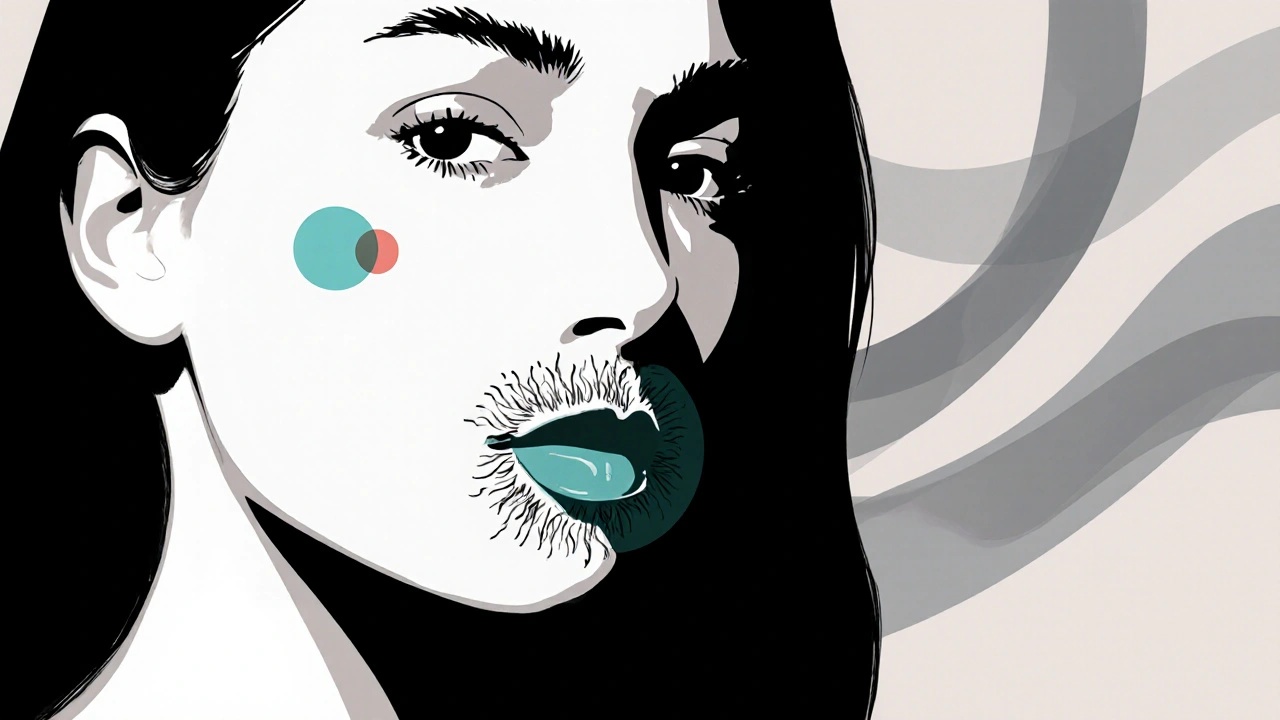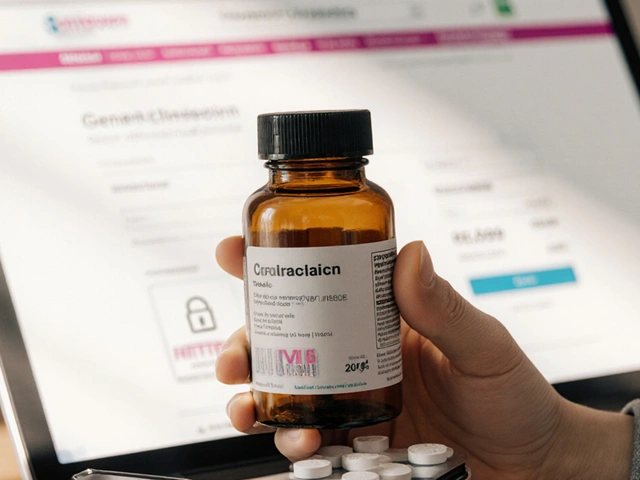Hirsutism Treatment Calculator
Recommended Options:
Potential Side Effects:
Expected timeline for results:
When unwanted facial or body hair becomes a daily frustration, many women wonder if their birth control pill could help. Hirsutism is a condition where excess hair grows in a male‑pattern distribution - chin, chest, abdomen or back - due to higher than normal androgen activity. Understanding how hormonal birth control interacts with the hormones that drive hair growth can turn a confusing topic into a clear action plan.
What Exactly Is Hirsutism?
Hirsutism affects roughly 5‑10% of women of reproductive age. It’s not just a cosmetic issue; the underlying hormonal imbalance can signal polycystic ovary syndrome (PCOS), adrenal disorders, or thyroid problems. The key players are androgens - male‑type hormones such as testosterone and dihydrotestosterone (DHT) - that bind to hair follicles and convert fine vellus hairs into coarse, pigmented terminal hairs.
- Typical onset: late teens to early 30s, but can appear at any age.
- Common sites: upper lip, chin, chest, abdomen, lower back, and inner thighs.
- Emotional impact: confidence loss, anxiety, and sometimes social withdrawal.
How Hormones Drive Unwanted Hair
Androgens are produced in the ovaries and adrenal glands. In women with hirsutism, either the production is higher, or the hair follicles are more sensitive to normal levels. Enzymes like 5‑alpha‑reductase convert testosterone into DHT, the form that most aggressively stimulates hair growth. A simple way to picture it: imagine a thermostat set too high - the body’s “heat” (androgen effect) stays on, making hair follicles think it’s spring all year.
Why Birth Control Can Influence Hair Growth
Combined hormonal contraceptives (CHCs) contain both estrogen and a progestin. The estrogen component raises sex‑binding globulin (SHBG) levels, which bind free testosterone, lowering the amount of active androgen that reaches the skin. Certain progestins also have anti‑androgenic properties, further dampening the hair‑stimulating signal.
Not every pill works the same. The degree of androgen suppression depends on the type of progestin and the estrogen dose. Understanding these nuances helps you pick a pill that tackles hirsutism without compromising other health goals.

Key Birth Control Options and Their Effect on Hirsutism
| Method | Typical Use | Effect on Hair Growth | Common Side Effects | Best For |
|---|---|---|---|---|
| Combined oral contraceptive (COC) | One pill daily | Significant reduction (30‑70% decrease in hair density after 6‑12months) | Nausea, breast tenderness, breakthrough bleeding | Women with PCOS or mild‑to‑moderate hirsutism |
| Progestin‑only pill (POP) | One pill daily | Minimal impact; some newer progestins (e.g., drospirenone) have mild anti‑androgenic effect | Irregular bleeding, weight gain, mood changes | Women who can’t take estrogen (e.g., migraine sufferers) |
| Spironolactone (off‑label) | 50‑100mg daily, often combined with COC | Moderate reduction (20‑50% after 6months); works best with estrogen therapy | Increased potassium, menstrual irregularities, dizziness | Women with high androgen levels not fully controlled by COC alone |
| Levonorgestrel IUD | Inserted by clinician, lasts 3‑5years | Little to no effect on hair growth | Cramping, spotting, expulsion | Women needing long‑term contraception without estrogen |
| Non‑hormonal methods (copper IUD, barrier) | Varies | No impact on hirsutism | Potential for heavier periods (copper IUD), user error (condoms) | Women who prefer to avoid hormones altogether |
Among these, the COC with a third‑generation progestin (e.g., desogestrel) or a newer anti‑androgenic progestin (drospirenone) consistently shows the strongest hair‑reduction benefits.
When Birth Control Alone Isn’t Enough
Some women have hirsutism that persists despite optimal COC use. In those cases, clinicians often add Spironolactone or consider other anti‑androgen medications like finasteride (used off‑label). Cosmetic procedures - Laser hair removal or electrolysis - can provide longer‑term reduction for stubborn areas. Combining medical and cosmetic approaches yields the fastest, most satisfying outcomes.
Potential Side Effects and How to Manage Them
- Weight changes: Estrogen can cause mild fluid retention. Focus on balanced diet and regular activity.
- Breakthrough bleeding: Often resolves after 3‑4 months. If it continues, a switch to a different progestin may help.
- Blood pressure rise: Certain progestins (e.g., cyproterone) can increase BP. Monitor quarterly if you have hypertension history.
- Potassium elevation with spironolactone: Routine labs every 6months are recommended.
Open communication with your HCP ensures any side effect is addressed promptly, allowing you to stay on the most effective regimen.
Choosing the Right Regimen - A Quick Decision Checklist
- Do you have any contraindications to estrogen (migraine with aura, clotting disorders)? If yes, consider progestin‑only or non‑hormonal options.
- Is your hirsutism mild, moderate, or severe? Mild cases may improve with a standard COC; severe cases often need COC + spironolactone.
- Are you also seeking contraception for pregnancy prevention? If so, a COC doubles as birth control.
- Do you have a diagnosis of PCOS or another endocrine disorder? Tailor the choice to address both symptoms.
- How comfortable are you with regular blood tests? Spironolactone requires monitoring.
Answering these questions with your doctor narrows the field to the safest, most effective plan for you.
Living with Hirsutism: Lifestyle Tips That Complement Medication
- Maintain a healthy weight: Excess fat can increase peripheral conversion of testosterone to DHT.
- Exercise regularly: Strength training can improve insulin sensitivity, which in turn lowers androgen production.
- Balanced diet: Focus on low‑glycemic foods, plenty of vegetables, and omega‑3 fatty acids.
- Stress management: Chronic stress spikes cortisol, which may exacerbate hormonal imbalance.
While none of these habits replace medication, they create an environment where hormonal treatments work more efficiently.
Frequently Asked Questions
Can I start a birth control pill solely to treat hirsutism?
Yes. Many clinicians prescribe a combined oral contraceptive specifically for its anti‑androgenic effects, even if pregnancy prevention isn’t the primary goal. Discuss dosage and progestin type with your provider.
How long before I see a visible reduction in hair?
Most women notice a 20‑30% reduction after three to six months of consistent COC use. Full results can take up to a year, especially for coarse facial hair.
Is spironolactone safe for long‑term use?
When monitored, spironolactone is safe for many years. Regular potassium checks and blood pressure monitoring are essential, but serious complications are rare.
What if I can’t tolerate estrogen?
Progestin‑only pills, the levonorgestrel IUD, or non‑hormonal methods can be combined with anti‑androgen drugs like spironolactone. The hair‑reduction effect may be slower but still significant.
Will laser hair removal work better after hormone therapy?
Yes. Reducing androgen‑driven hair growth first makes laser sessions more effective and reduces the number of treatments needed.
Armed with the right information, you can choose a birth control method that not only prevents pregnancy but also tackles the root cause of unwanted hair. Talk to a trusted healthcare professional, weigh the pros and cons, and give the chosen regimen a few months to show results. Patience and collaboration are the keys to reclaiming confidence.






11 Comments
king singh
October 16, 2025 AT 17:17 PMThanks for the thorough overview, it really clears up a lot.
Adam Martin
October 23, 2025 AT 15:57 PMOh great, another miracle pill that promises to turn your unwanted fur into silky smooth skin while also preventing pregnancy.
Because nothing says “I trust modern medicine” like swallowing a cocktail of hormones that were originally designed for contraception.
The article nicely points out that not every pill works the same, which is reassuring for those of us who love to read fine‑print.
I especially appreciate the reminder that estrogen raises SHBG, because who doesn’t enjoy a good dose of biochemistry with their morning coffee?
And let’s not forget the progestins that “sometimes” have anti‑androgenic properties-such a clear and decisive statement.
The table is a masterpiece of clinical clarity, listing side effects like nausea and breakthrough bleeding right next to hair reduction percentages.
If you’re into statistics, the 30‑70% decrease after six months is practically a lottery ticket for smoother cheeks.
Of course, the article also cautions that some women may need spironolactone, because why settle for one pill when you can combine a few?
The suggestion to add laser hair removal after hormonal therapy is a nice touch-nothing like a little light show after you’ve taken your daily dose.
I love the checklist at the end; it’s like a choose‑your‑own‑adventure for hormonal chaos.
“Do you have any contraindications to estrogen?”-the ultimate conversation starter at brunch.
And the lifestyle tips, like exercising and eating low‑glycemic foods, are there just in case you’ve run out of pills.
It’s comforting to know that weight loss can also lower androgen conversion-so perhaps my treadmill will finally pay off.
The article’s tone stays respectfully clinical while sprinkling hope, which is exactly how I like my medical advice: bland but optimistic.
In short, if you’re looking to kill two birds with one pill-prevent pregnancy and prune your beard-this guide has you covered.
Just remember to monitor your potassium if you’re on spironolactone, because the last thing you want is a surprise trip to the ER after a hair‑free weekend.
Ryan Torres
October 30, 2025 AT 13:37 PMThe hormone combo in birth control is just a clever way for Big Pharma to keep us hooked on endless prescriptions 😤. They hide the fact that these pills manipulate your endocrine system to suppress natural androgen production, making you dependent on their product line 😡. Don't be surprised when they push spironolactone as a “necessary” add‑on, while quietly monitoring your potassium levels for profit. Keep an eye on the lab results, because the system wants you confused.
shashi Shekhar
November 6, 2025 AT 12:17 PMSure, because a tiny copper IUD can magically fix hormonal chaos-yeah right. The article's claim that non‑hormonal methods have no impact on hirsutism is as solid as a sandcastle in a storm. If you enjoy waiting years for a miracle, go ahead, but don’t blame us when the hair stays.
Marcia Bailey
November 13, 2025 AT 10:57 AMGreat job breaking down the options, this is exactly the kind of practical info we need 😊. Remember to discuss any side effects with your provider, and don’t hesitate to ask for labs when starting spironolactone. You’ve got this, and we’re all rooting for your confidence boost! 👍
Hannah Tran
November 20, 2025 AT 09:37 AMFrom an endocrinological perspective, the suppression of free testosterone via SHBG upregulation is a key pharmacodynamic endpoint. Clinically, selecting a third‑generation progestin optimizes the androgen receptor antagonism, thereby enhancing the therapeutic ratio. However, adherence remains the pivotal determinant of efficacy, so patient education must be prioritized. Let’s keep pushing for protocols that integrate both hormonal and non‑hormonal adjuncts.
Crystle Imrie
November 27, 2025 AT 08:17 AMSounds like another textbook solution-big surprise.
Shelby Rock
December 4, 2025 AT 06:57 AMi think we r all chasing a perfect 0 hair count, but nature wil always find a way to remind us u cant control everything. sometimes a little fuzz is just the universe's way of saying "i see u". embrcae the chaos, it might teach u more than any pill could.
Dhananjay Sampath
December 11, 2025 AT 05:37 AMIndeed, the comprehensive table offers a clear, concise, and remarkably detailed comparison, allowing readers to weigh benefits, risks, and personal preferences with confidence; however, one must also consider individual variability in response to hormonal therapy, which underscores the importance of personalized medical guidance.
kunal ember
December 18, 2025 AT 04:17 AMWhen evaluating the efficacy of combined oral contraceptives for hirsutism, it is essential to examine both the pharmacokinetic profile of the estrogen component and the specific anti‑androgenic activity of the progestin. Studies have demonstrated that third‑generation progestins, such as desogestrel, produce a modest increase in SHBG levels, thereby reducing the bioavailability of circulating testosterone. Moreover, the duration of therapy plays a significant role; most clinicians observe appreciable hair density reduction after a minimum of six months of continuous use. Patients should also be counseled regarding potential adverse effects, including breakthrough bleeding, which typically resolves within the first trimester of treatment. Monitoring of metabolic parameters, particularly in those with pre‑existing insulin resistance, can further optimize outcomes. Finally, integrating lifestyle modifications-such as regular aerobic exercise and a low‑glycemic diet-creates a synergistic environment that enhances the hormonal regimen's effectiveness. In summary, a nuanced, individualized approach remains the cornerstone of successful hirsutism management.
Kelly Aparecida Bhering da Silva
December 25, 2025 AT 02:57 AMDon't be fooled by the mainstream narrative that paints these birth‑control options as neutral; they are a tool of globalist agendas aiming to control women's bodies and diminish cultural identity 😤. Our heritage demands we protect natural femininity without caving to foreign pharmaceutical monopolies. Stand firm, question the protocol, and choose what aligns with our nation's values.